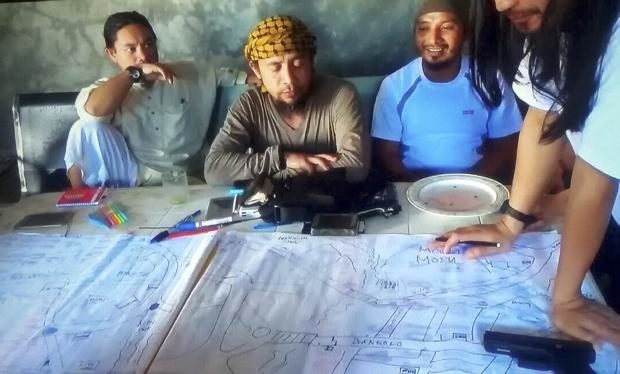
This image taken from undated video shows the purported leader of the Islamic State group Southeast Asia branch, Isnilon Hapilon (center) at a meeting of militants at an undisclosed location. The images offer a rare glimpse into the clandestine operations of insurgents who followed through two weeks ago with an unprecedented assault on the lakeside city of Marawi, parts of which they still occupy today. (Photo via AP)
MARAWI CITY- Armed Forces Chief Gen. Eduardo Año said on Monday the military would have wanted to catch Isnilon Hapilon and Omar Maute alive but they fought.
“They were attempting to go out to the street to escape. In fact, there were four boats ready on the lake. They had it built by the hostages so they really planned to get out,” Año said in a press briefing in Marawi Monday afternoon.
Omar and Hapilon were among nine bodies recovered after the fighting that started 2 a.m. and ended at 6 a.m. Monday, Año added.
Año said the remaining gunmen, about 30, would be killed, too, if they would not surrender.
“Our objective is to end the siege by neutralizing them and make sure they could not escape. We will end the ISIS (Islamic State) siege here,” he said.
Defense Secretary Delfin Lorenzana said that while the Armed Forces of the Philippines was sure to end the IS here, the government will also make sure that the ideology it has planted would be nipped.
“We have talked with the imams and they agreed to cooperate so that we can counter this foreign ideology. We will start in the madrasas (Islamic schools) and also the communities,” he said.
Año said the killing of the two leaders also boosted the morale of the soldiers.
“I have visited them and they are relieved and ecstatic. They are very happy for the accomplishment,” he said.
Hapilon’s death came during a push to end the four-month siege of Marawi, a battle that has claimed more than 1,000 lives and raised fears that IS was seeking to set up a regional base in Mindanao.
President Rodrigo Duterte and security analysts said Hapilon has been a key figure in the jihadist outfit’s drive to establish a Southeast Asian caliphate as they suffer battlefield defeats in Iraq and Syria.
The US government had offered a $5 million bounty for information leading to Hapilon’s arrest, describing the 51-year-old as a senior leader of the southern Philippines-based Abu Sayyaf group, which the US considers a “foreign terrorist organization”.
DNA tests will be carried out on the two bodies because of the reward offer from the US and Philippine governments, he added.
“The implication of this development is that the Marawi incident is almost over and we may announce the termination of hostilities in a couple of days,” Lorenzana said.
Philippine authorities have made several previous announcements on the imminent end of the conflict, but observers believe this time the forecast is likely to be accurate.
Pro-IS gunmen occupied parts of Marawi on May 23 following a foiled attempt by security forces to arrest Hapilon, authorities said.
The military said Hapilon joined forces with the Maute group to plan the rampage.
Since then more than 1,000 people have been killed and 400,000 residents displaced.
Duterte has imposed martial law across the southern third of the Philippines to quell the militant threat.
‘Center of gravity’
The insurgents have withstood a relentless US-backed bombing campaign and intense ground battles with troops that have left large parts of Marawi in ruins.
Defense chiefs last month said other Philippine militant leaders had been killed in the battle for Marawi.
Troops were still pursuing Malaysian Mahmud Ahmad in the Marawi battle zone, Lorenzana said on Monday, describing him as the “conduit” between IS and local militant groups.
Mindanao is home to a decades-old Muslim separatist insurgency and to extremist gangs that have declared allegiance to IS including the Abu Sayyaf and Maute groups.
Hapilon is believed to have been involved in the 2001 kidnappings of three Americans, two of whom were later killed.
Hapilon was based on Basilan Island in the strife-torn south but authorities said in January that he had moved to the Mautes’ base in Lanao del Sur to create an alliance and to establish an IS presence there.
Marawi is Lanao del Sur’s capital and largest city.
The deaths of Hapilon and Maute signal the end of the militant groups, the Año said.
“This means their center of gravity has crumbled,” Año said.
“We just needed to get these two (leaders) to make sure the leadership, the center of gravity falls, and elsewhere even the Maute-ISIS (fighters) in other areas would also crumble.”
However an analyst said the deaths of the leaders would likely prompt retaliatory attacks from their followers and allies, with young leaders seeking to take their place.
“Terrorism will take a new form in the post-Marawi period because these terrorist groups linked to ISIS continue to innovate and their actions are evolving,” Rommel Banlaoi, chairman of the Philippine Institute for Peace, Violence and Terrorism Research, told Agence France Presse.
“It’s going to be a new battle.”/ With a report from Agence France Presse/ac